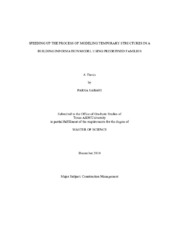| dc.description.abstract | It has been less than a decade that Building Information Modeling (BIM) has been used in construction industries. During this short period of time the application of this new modeling approach has increased significantly, but still the main users of such models are architects (for design purposes) and general contractors (for coordination purposes). Most of the BIM applications are developed to meet design and coordination requirements; yet sub-contractors face hassles when using this new technology to model their products, equipment and services in detail. The literature reveals that one of the reasons is they do not have access to the tools and objects they need to model their work within the BIM environment. Temporary structures, such as shoring systems and formworks, are good examples. Although these structures play a significant role in the logistics of the jobsite, there are neither a special tools nor predefined objects in BIM applications to help model these elements.
In this case study a real building project has been used to model these temporary structures by two different methods: 1. Using ordinary tools in BIM application (Revit), and, 2. Using predefined parametric families of objects developed and customized for this project. During the modeling process, time has been recorded as well as other observations describing obstacles, advantages, and disadvantages of both methods. The results show that the usage of predefined parametric families speeds up the process of modeling and also helps to create a model which is more understandable and informative than 2D drawings that are currently being used by most of the sub contractors. | en |


